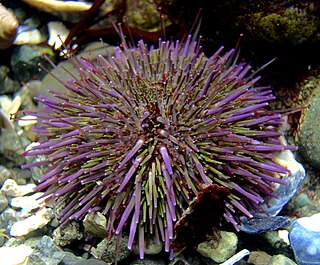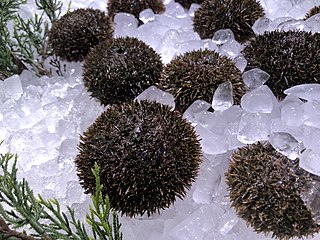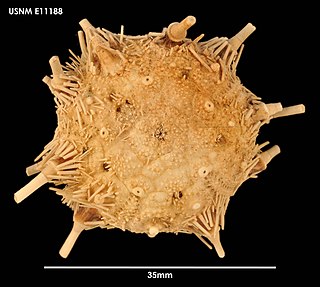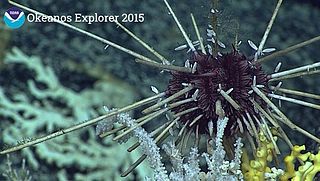
The Diadematidae are a family of sea urchins. Their tests are either rigid or flexible and their spines are long and hollow.

Cidaris is a genus of pencil sea urchins.

The purple sea urchin, Strongylocentrotus purpuratus, lives along the eastern edge of the Pacific Ocean extending from Ensenada, Mexico, to British Columbia, Canada. This sea urchin species is deep purple in color, and lives in lower inter-tidal and nearshore sub-tidal communities. Its eggs are orange when secreted in water. January, February, and March function as the typical active reproductive months for the species. Sexual maturity is reached around two years.
Bald sea urchin disease is a bacterial disease known to affect several species of sea urchins in the Mediterranean Sea, North Atlantic and along the California coastline. Research suggests two pathogens are responsible for the disease, Listonella anguillarum and Aeromonas salmonicida.

Coelopleurus is an extant genus of echinoids with fossil records dating back to the Eocene, with remains found in Europe and North America.

Hemicentrotus pulcherrimus is a species of sea urchin, the only one in the monotypic genus Hemicentrotus. It was first described by the American engineer and marine zoologist Alexander Agassiz in 1864 as Psammechinus pulcherrimus. Its range extends along the coasts of Korea and China, and in Japan from Kyūshū to Ishikari Bay. An edible species, it is harvested from Kyūshū to Fukui, in the Sea of Japan.

Cidaridae is a family of sea urchins in the order Cidaroida.

Spatangus is a genus of heart urchins in the Spatangidae family. The genus is synonymous with the previously recognised genera Prospatangus Lambert, 1902 and Spatagus. There are nine recognised species. The type species is Spatangus purpureus Müller, 1776 by subsequent designation.

Toxopneustidae is a family of globular sea urchins in the class Echinoidea.

The Camarodonta are an order of globular sea urchins in the class Echinoidea. The fossil record shows that camarodonts have been in existence since the Lower Cretaceous.

Lovenia is a genus of sea urchin that is the sister taxon to Berynia and Echinocardium.

Clypeaster, common name "cake urchins" or "sea biscuits", is a genus of echinoderms belonging to the family Clypeasteridae.
Aporocidaris fragilis is a species of sea urchin of the family Ctenocidaridae. It is well-armoured with spines. It is placed in the genus Aporocidaris and lives in the sea. Aporocidaris fragilis was first scientifically described in 1907 by Alexander Emanuel Agassiz & Hubert Lyman Clark.

Lytechinus is a genus of sea urchins.

Chaetodiadema is a genus of sea urchins of the Family Diadematidae. Their armour is covered with spines.

Araeosoma is a genus of deep-sea sea urchins in the family Echinothuriidae.

Aporocidaris is a genus of sea urchins in the family Ctenocidaridae. Several species are found in deep water in circum-Antarctic locations.

Histocidaris is a genus of sea urchins in the family Histocidaridae. Some species are known from the fossil record.

Echinobase is a web information system that catalogs diverse genomic and biological data for the echinoderm clade. The system provides a gene search engine, genomics browser and other bioinformatics tools to explore genomic and transcriptomic data. The Echinobase information system focuses on information from eight echinoderm research models: Strongylocentrotus purpuratus, Strongylocentrotus fransciscanus, Allocentrotus fragilis, Lytechinus variegatus, Patiria miniata, Parastichopus parvimensis and Ophiothrix spiculata, Eucidaris tribuloides. The goal of Echinobase is to support molecular biological science including developmental processes and gene regulatory networks.

Caenopedina is a genus of sea urchins of the Family Pedinidae.






















